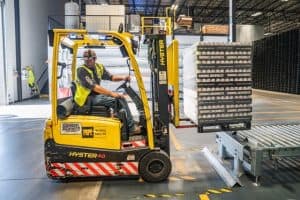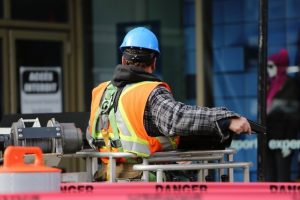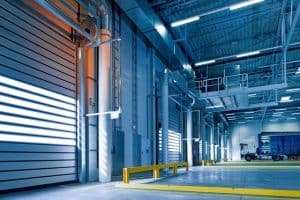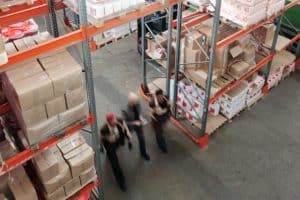Warehouse forklift safety introduction
Operating an industrial truck such as a forklift is a vital responsibility for any warehouse or manufacturing facility. Not only must the driver be competent and trained, but the safety of pedestrians in the work area is also paramount. This article will explore the importance of forklift pedestrian safety and provide insight into how to best protect your team of employees from costly and potentially life-threatening accidents. We’ll start by discussing the need for proper eye contact and awareness of blind spots.
Blind Spots
One of the most important aspects of forklift pedestrian safety is maintaining eye contact with pedestrians in order to ensure that they are aware of the truck’s presence. Drivers should also be aware of any potential blind spots, such as corners or other areas where people may not be visible from the cab. Drivers should also take care to slow down or stop when approaching a corner or any other area that may be difficult to see.
Speed limiting
The use of speed limits is also an important factor in forklift safety. The Occupational Safety and Health Administration (OSHA) sets the maximum speed limit for industrial trucks at 5mph, and this should be strictly adhered to. This will help reduce the risk of accidents and allow pedestrians enough time to move out of the way if necessary.
Mirrors
The use of convex mirrors can also be a useful safety feature in areas where blind spots may be present. These mirrors are placed at strategic locations so that drivers can get a better view of their surroundings, and they also act as a reminder for people walking in the area to stay alert and aware of any vehicles operating nearby.
These tools can be used to improve visibility and reduce the risk of collisions between pedestrians and forklifts. Additionally, these items can be used to create a virtual “forklift lane” that will provide pedestrians with a clear path for walking around the work area without having to worry about being in the way of moving vehicles.
Exclusion zone
It is also important to ensure that forklifts and pedestrians are kept at a safe distance from each other. If possible, pedestrian walkways should be created and clearly marked with signs in order to provide a clearly defined path for people walking around the work area. This ensures that there is enough room for both forklifts and pedestrians to coexist without risk of collision. It is also important to consider the use of exclusion zones when it comes to forklift pedestrian safety. Exclusion zones can be implemented by designating areas where pedestrians and forklifts are prohibited from entering. This will help reduce the risk of accidents by ensuring that there are no people in close proximity to a moving vehicle. Additionally, any areas that are designated as exclusion zones should be clearly marked with signs. Following these simple tips will help
to ensure that everyone in the workplace is kept safe and secure.

The use of backup alarms and warning lights is also beneficial, as they provide an audible and visual warning that a vehicle is approaching. This can be particularly useful when there are multiple forklifts operating in the same area.
It is also important to consider the use of exclusion zones when it comes to forklift pedestrian safety. Exclusion zones can be implemented by designating areas where pedestrians and forklifts are prohibited from entering. This will help reduce the risk of accidents by ensuring that there are no people in close proximity to a moving vehicle. Additionally, any areas that are designated as exclusion zones should be clearly marked with signs. Following these simple tips will help to ensure that everyone in the workplace is kept safe and secure.
It is also important to consider the use of exclusion zones when it comes to forklift pedestrian safety. Exclusion zones can be implemented by designating areas where pedestrians and forklifts are prohibited from entering. This will help reduce the risk of accidents by ensuring that there are no people in close proximity to a moving vehicle. Additionally, any areas that are designated as exclusion zones should be clearly marked with signs. Following these simple tips will help to ensure that everyone in the workplace is kept safe and secure.
One very effective way to establish a safety exlusion zone around a vehicle that poses risk to warehouse pedestrian workers is to use electronic control methods. One very effective electronic control uses special sensors to detect pedestrian wearing Tags to prevent collision. These systems are typically adjustable (for instance, our BodyGuard pedestrian safety warning system has a 360 degree safety exclusion zone that is adjustable from 1.5m to around 9m and can detect people wearing tags right through most solid objects). These systems have a system that usually comprises a sensor unit and some type of warning or alert for the driver. Effective systems also typically alert with pedestrian also by using a light and or vibration on the tag device. The main advantages of this type of contol system are:
1. Does not require line of sight like traditional and newer A.I. systems require.
2. Overcomes human factors such as driver and/or pedestrian inattention
3. Eliminates blind spots around vehicle or due to pooor visibility in the warehouse environment
4. Does not exhibit false alarms. The Tag based systems will only alert when a person wearing a tag device breaches the safety exclusion zone around the forklift.
5. Requires no additional infrastructure to operate
6. Provides real-time warning to revent a collision or accident involving death or injury.
Click here to learn how the BodyGuard pedestrian safety warning system can help you keep your pedestrian staff and forklifts apart in your warehouse environment.
Training
It is important to invest in proper forklift safety training for all of your employees. Training should focus on proper operation and maintenance of the equipment while also providing guidance for pedestrians on how to safely interact with the vehicles. This will not only reduce the risk of accidents, but will also improve employee morale and productivity.
Traffic management plan
Creating a traffic management plan is also essential to ensure that everyone in the work area is kept safe. This plan should include measures such as designating dedicated lanes for pedestrians and forklifts, assigning specific times of the day when forklifts are allowed to operate, and ensuring that operators are trained on how to safely maneuver around other workers. Additionally, electric forklifts may be more suitable for use around pedestrian workers than those that require the use of an elevated load.
Personal protection equipment (PPE)
It is important to enforce the use of protective gear for all workers in the area. Workers who are required to operate forklifts should be equipped with hard hats and safety glasses, while pedestrians should always wear reflective clothing when near a moving vehicle. The establishment of a “no cell phone” policy is also beneficial, as this will help to reduce distractions and promote focus on the task at hand.
Conclusion
It is essential to ensure that pedestrian workers and forklift operators are kept safe at all times. By providing proper training and investing in quality safety equipment, you can help minimize the risk of catastrophic accidents while also making your workplace more productive and efficient.
By following these basic safety guidelines, you can help ensure that your team is protected from forklift-related injuries and accidents. Investing in quality training and equipment will go a long way towards creating an accident-free workplace – one that is both productive and safe
